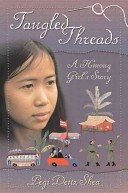by Julia López-Robertson, Michelle Metts and Tracy Spires, University of South Carolina
 Immigrant students face significant challenges in balancing their home culture and American culture. In Tangled Threads: A Hmong Girl’s Story (Shea, 2003), Heather and Lisa assimilated to the American culture and brought heartache and disappointment to their parents and grandmother. Many parents display tremendous bravery in bringing their families to America, only to lose their children to American culture (Buley-Meissner, 2002). ESOL (English to Speakers of Other Languages) teachers can assist students in embracing their home culture. Emergent bilinguals who were born in the United States are not always familiar with their history. As Nor Vang explains in the Buley-Meissner (2002) article “without history, I don’t know my own being in the world. I don’t know my place in my family or my right to be in this country” (p. 327). Using books, discussions, and life stories we can help our students learn about and develop an appreciation for their background. In Tangled Threads, Mai was able to embrace the Hmong traditions and be proud of her heritage. Mai embodied the dual culture that Xiong speaks of in The Spirit of the People: Hmong American Life Stories, “the Hmong gave me life; the American culture gave me freedom. Both make me who I am” (Buley-Meissner, 2002, p. 330).
Immigrant students face significant challenges in balancing their home culture and American culture. In Tangled Threads: A Hmong Girl’s Story (Shea, 2003), Heather and Lisa assimilated to the American culture and brought heartache and disappointment to their parents and grandmother. Many parents display tremendous bravery in bringing their families to America, only to lose their children to American culture (Buley-Meissner, 2002). ESOL (English to Speakers of Other Languages) teachers can assist students in embracing their home culture. Emergent bilinguals who were born in the United States are not always familiar with their history. As Nor Vang explains in the Buley-Meissner (2002) article “without history, I don’t know my own being in the world. I don’t know my place in my family or my right to be in this country” (p. 327). Using books, discussions, and life stories we can help our students learn about and develop an appreciation for their background. In Tangled Threads, Mai was able to embrace the Hmong traditions and be proud of her heritage. Mai embodied the dual culture that Xiong speaks of in The Spirit of the People: Hmong American Life Stories, “the Hmong gave me life; the American culture gave me freedom. Both make me who I am” (Buley-Meissner, 2002, p. 330).
Mai’s ESOL teachers, Miss Sayapong and Miss Susan, played a significant role in shaping her life and helping Mai to appreciate her heritage. They assisted her academically as she learned English and also emotionally as she faced numerous adjustments and challenges. Yuh (2005) explains that “refuge migrants are motivated by a deep psychological need to leave behind chaos, and insecurity, and trauma, and they seek out emotional/mental peace and a stable environment that doesn’t feel like it’s always threatening to explode” (p. 281). ESOL teachers have the opportunity to create a safe and stable environment for their students in the classroom. Emergent bilinguals need someone they can trust and share their personal stories. Some teachers have found that using journals allows their students to process past experiences as well as current issues.
Mai’s teachers set high expectations for her and she was successful in school. However, Heather and Lisa lacked the motivation to succeed academically. Buley-Meissner (2002) included research that identified a surprising pattern – “students who are born in America and have a good command of English are more likely to do poorly and drop out than students who arrive from Laos and Thailand and learn English as a second language” (p. 324). In Tangled Threads, Heather dropped out of school and moved away with her boyfriend. Lisa married at the age of 15, a common event in Hmong families, and became pregnant. ESOL teachers have to balance cultural traditions with American expectations. Share your ideas about how ESOL teachers can help ALL students succeed.
Buley-Meissner, M. (2002). The spirit of a people: Hmong American life stories. Language Arts, 79(4), 323-331.
Shea, P. (2003). Tangled Threads: A Hmong Girl’s Story. New York: Clarion Books.
Yuh, J. (2005). Moved by war migration, Diaspora and the Korean War. Journal of Asian American Studies, 8(3), 277-291.
Journey through Worlds of Words during our open reading hours: Monday-Friday, 9 a.m. to 5 p.m. and Saturday, 9 a.m. to 1 p.m.

This sounds like a great book. I can’t wait to read it and give back feedback. As educators we need to be aware of how ELL children are feeling and coping in a classroom. We need to bring books into our classrooms to help incorporate a multiculture curriculum.
This is one of few books that can contribute reading about different refugee migrant experiences.Stories about Hmong children’s voices are something we don’t hear or read often in the U.S. The book like this may challenge the common collective understanding toward socio-political and cultural group such as refugee migrants and other immigrants.